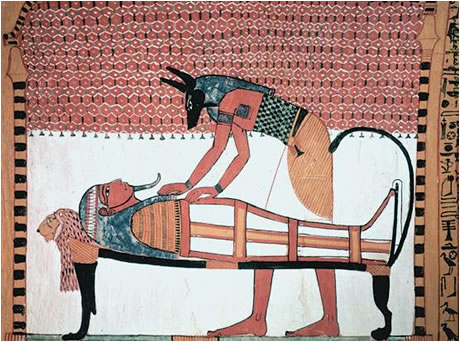Week 4: Medicine +Technology+Art
This week's topic was about the intersection of medicine, technology, and art. As someone who has spent time researching and learning about medicine, I found this very topic to be very interesting.
 |
| Dissection in Ancient Egypt |
Our speaker for this week, Patricia Olynyk, gave a fascinating lecture on how medicine has shaped the perception of the human body. Professor Vesna spoke more about this idea in her lecture videos and explained that with the development of technology like CAT scans and MRIs, society's perception of the human body is shifting. Methods of dissection have been used for centuries within all different cultures, but only in the last 100 years has technology allowed for digital dissections. In my high school sports medicine class, we were allowed to try out an Anatomage table which allows for digital dissection and a 3D representation of the human body.
 |
| "Body Worlds" Exhibition |
I am deeply impressed with how far technology has come. I also think it is great that people have become so appreciative of the intersection of technology and medicine because it was not always like this. Vesna explained that the belief in the early 20th century was that you weren't a "real" doctor if you used technology in medicine. I'm glad we have collectively moved past this belief and now use technology to save people's lives!
CentralOhioTech. “Hands-on Learning: Anatomage Table.” YouTube, YouTube, 10 May 2019, www.youtube.com/watch?v=h8IyALBJiXE.
“HIS 101 Western Civilization 1: Ancient Egypt.” LibGuides, nvcc.libguides.com/c.php?g=169561&p=1115526.
“Medicine pt1.” YouTube, 21 Apr. 2012, youtu.be/Ep0M2bOM9Tk.
“Medicine pt2.” YouTube, 21 Apr. 2012, youtu.be/psjnQarHOqQ.
“People - Photos: Bodies Exhibit, Human Body Exhibit, Body Anatomy.” Pinterest, www.pinterest.com/pin/449867450248113892/.
“TEDxAmericanRiviera - Diane Gromala - Curative Powers of Wet, Raw Beauty.” YouTube, 7 Dec. 2011, youtu.be/cRdarMz--Pw.
Tyson, Peter. “The Hippocratic Oath Today.” PBS, Public Broadcasting Service, 27 Mar. 2001, www.pbs.org/wgbh/nova/article/hippocratic-oath-today/.

I also found this weeks topic very interesting. It's fascinating how the advancements in technology has allowed people in the medical field to work more efficiently. The Body Worlds exhibition seems cool, I haven't really been to many like those except for the science centers Tess, it's a 50 foot Woman with visible organs which teaches visitors about homeostasis.
ReplyDeleteI found your blog post very interesting, and I think it's super cool how you were able to visit the Body Worlds exhibit. It is very strange that doctors back in the day were not accustomed to using technology, because in today's world we can't imagine one without the other. I also found your discussion about imaging technologies such as MRIs very interesting, as it seems that the connection between art and medicine has a positive correlation with increasing technology in medicine.
ReplyDelete